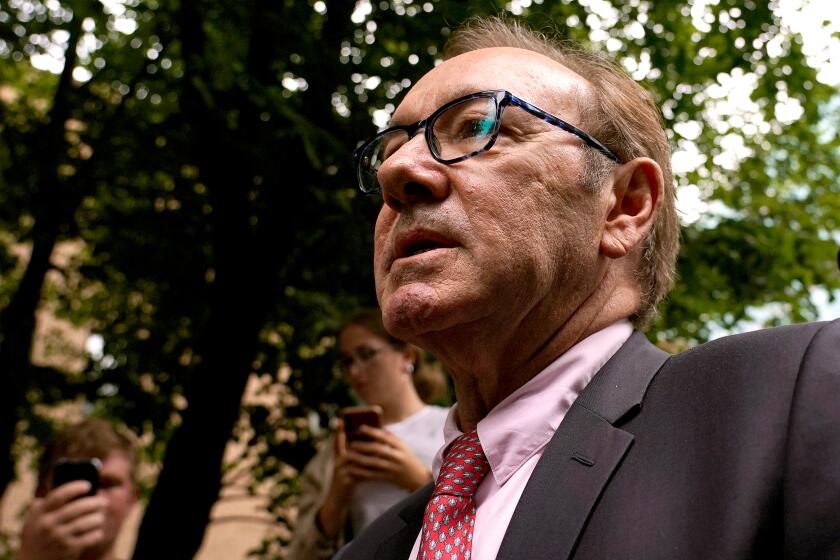Don’t Kick Sand on ‘Beach’ Movies
As a young assistant director in the ‘60s, I was the only member of our production team to work on all of Annette Funicello’s quite successful “Beach Party”-type motion pictures. I now find it interesting that in your interview with her (“There’s That ‘Annette Sound,’ ” Calendar, Sept. 27), you referred to those projects as “silly beach movies.” I wonder what (usually right-on) writer Chris Willman meant by “silly.” Let’s see:
* We shot those films in less than a month, and they only cost $500,000 to produce; yet, they grossed $10 million to $30 million--long before home video, cable TV or merchandise licensing became mainstays of huge ancillary revenues.
* These movies afforded hopefuls an opportunity to break into the industry, and they provided invaluable career-growth vehicles for an impressive amount of on-the-way-up acting and musical talent (e.g., Funicello, Frankie Avalon, Teri Garr, Dwayne Hickman, Meredith MacRae, Linda Evans, James Brown, Dick Dale, Stevie Wonder).
* They generated wide exposure for many well-known pros (e.g., Mickey Rooney, Oscar winner Dorothy Malone, Keenan Wynn, Bob Cummings, Elsa Lanchester, Paul Lynde, Dorothy Lamour, Vincent Price, Buster Keaton).
* They found a new audience-following for established nightclub comics, broadly expanding their overall appeal in the entertainment marketplace (e.g., Buddy Hackett, Morey Amsterdam, Don Rickles).
* They were all shot in Hollywood, contributing to the local economy by providing hundreds of jobs and thousands of work-hours for many capable people, never failing to honor our contracts with every guild and union in the industry.
* They created even more jobs, utilizing the talents of literally hundreds of additional actors, athletes, atmosphere players, stunt people, crew members and production staff, so we could shoot our own exciting chase (or surfing or sky diving or auto racing or skiing) sequences, creatively choosing not to simply do it the cheap “B-picture” way--renting library footage previously shot by someone else.
* The men and women cast members were equally attractive; they were of equal athletic and dancing ability, and they were even paid equally. There might have been lots of girlfriend/boyfriend showing off, jealousy and game-playing, but the lead characters (including those, for example, portrayed by Funicello and Avalon) were consistently presented as gender-equal--not on a sex-for-date basis. Proudly, that was 25 or 30 years ago.
* The sexiest of scenes (comprising as many as two or three hugs and kisses!) could conveniently be interrupted by cutting away to an extreme close-up of someone yelling, “Surf’s up!” Audiences didn’t feel cheated out of a sexy scene, either--after all, the surf was up. To the viewers’ delight, that signaled a spectacular surfing montage. Now that was a hot, on-screen, male-female “action sequence”!
* No one bought, sold or used either drugs or automatic weapons, the “coke” consumed on- and off-camera was Coca-Cola, and nobody got shot.
* All over the Free World, these features filled a huge product void that always triggered a burst of desperately needed ticket sales, allowing countless theaters to simply stay in business, while enabling many others to increase hiring.
* We learned that sometimes by nearly leaving a few things unsaid, implied and to the viewer’s imagination--amazingly enough--the film medium could still work as a viable, entertaining, profitable method of storytelling.
* Each of those films offered fun and smiles for moviegoers--no matter what their ages!
That’s silly?
*
A final note: Funicello--former Mouseketeer or not--was way off-base in one of her responses to your many interview questions. Reminiscing about her long career, she said: “I don’t think I ever really had sex appeal.”
Sorry. Not only did she have sex appeal back then, to be certain, she still has it today. A lot of it.
More to Read
Only good movies
Get the Indie Focus newsletter, Mark Olsen's weekly guide to the world of cinema.
You may occasionally receive promotional content from the Los Angeles Times.






